History of Saint John, New Brunswick
This article details the history of Saint John, New Brunswick. Predated by the Maritime Archaic Indian civilization, the area of the northwestern coastal regions of the Bay of Fundy is believed to have been inhabited by the Passamaquoddy Nation several thousand years ago, while the Saint John River valley north of the bay became the domain of the Maliseet Nation. The Mi'kmaq also ventured into the territory and named the area ''Měnagwĕs'', which means "where they collect the dead seals."[1]
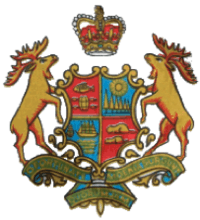
French colony
The mouth of the Saint John River was first discovered by Europeans in 1604 during a reconnaissance of the Bay of Fundy undertaken by French cartographer Samuel de Champlain. The day upon which Champlain sighted the mighty river was St. John The Baptist's Day, hence the name, which in French is Fleuve Saint-Jean. The city has the same name in English as well as French.[2]
The strategic location at the mouth of the Saint John River was fortified by Charles de la Tour in 1631. The fort was named Fort Sainte Marie (AKA Fort La Tour) and was located on the east side of the river. To the west of the Saint John River, Fort Saint-Jean was later built (c. 1790).[3]
Raid on St. John (1632)
Precipitated by the arrival of the new French governor of Acadia, Isaac de Razilly, on 18 September 1632, Captain Andrew Forrester, commander of the then Scottish community of Port Royal, Nova Scotia, crossed the Bay of Fundy with twenty-five armed men and raided Fort Sainte-Marie. Symbolically, Forrester's men knocked down the large wooden cross and arms of the king of France before plundering the fort. They seized the fort's personnel and their stock of furs, merchandise, and food. Forrester took his prisoners and loot to Port Royal.[4] This conflict was the last fighting, between the Scots and the French, before Port Royal was returned to the French.[5]
Acadian Civil War
Blockade of St. John (1642)
Charles de Saint-Étienne de La Tour and Charles de Menou, Sieur d'Aulnay each had a claim of some legitimacy to be Governor of Acadia because the French Imperial bureaucracy made their appointments with an incomplete understanding of the geography of the area. LaTour had a fortified settlement at the mouth of the Saint John River while d'Aulnay's headquarters was at Port Royal some 45 miles across the Bay of Fundy. In adjoining New England, the people supported LaTour's claim since he allowed them to fish and lumber in and along the Bay of Fundy without let or hindrance while d'Aulnay aggressively sought payment for that right. Word came to LaTour that d'Aulnay was concentrating men and materials for an attack on LaTour's fort and fur trading operation at the mouth of the Saint John River. LaTour went to Boston to ask John Winthrop, the governor of Massachusetts Bay colony, for help. Winthrop arranged for several merchants to advance loans unofficially to LaTour for his purchase of men and material to defend the Saint John River fort from d'Aulnay's attack. For five months, the Governor of Acadia d'Aulnay who was stationed at Port Royal created a blockade of the river to defeat La Tour at his fort.[6] On 14 July 1643, La Tour arrived from Boston with four ships and a complement of 270 men to repossess Fort Sainte-Marie. After this victory, La Tour went on to attack d'Aulnay at Port Royal, Nova Scotia.[7] LaTour was unsuccessful then in catching d'Aulnay and the rivalry continued for several more years.
Siege of St. John (1645)
While La Tour was in Boston, on Easter Sunday 13 April 1645, d'Aulnay sailed across the Bay of Fundy and arrived at La Tours fort with a force of two hundred men.[8] La Tour's soldiers were led by his wife, Françoise-Marie Jacquelin, who became known as the Lioness of LaTour for her valiant defence of the fort. After a five-day battle, on 18 April, d' Aulnay offered quarter to all if Francoise-Marie were to surrender the fort. On that basis, knowing she was badly outnumbered, she capitulated and d’Aulnay had captured La Tour's Fort Stainte-Marie. d'Aulnay then reneged on his pledge of safety for the defenders and treacherously hanged the La Tour garrison while Madame de la Tour was forced to watch with a rope around her neck. Three weeks later, while still in d'Aulnay's hands, she died.[9] With the death of his wife and the loss of his fort, La Tour did not return to Acadia for the next four years, until d'Aulnay had died (1650).[8] And when he did return, he married d’Aulnay's widow to end the rivalry. He and Madame d’Aulnay had five children in the result they have hundreds of descendants living in the Canadian Maritimes today.[10]
Battle of St. John (1654)
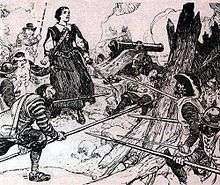
Colonel Robert Sedgwick led one hundred New England volunteers and two hundred of Oliver Cromwell's soldiers to capture Port Royal, Nova Scotia. Prior to the battle, Sedgewick captured and plundered La Tour's fort on the Saint John River and took him prisoner.[11]
British conquest: King William's War
Naval Battle of St. John (1696)
The Action of 14 July 1696 was a naval battle between New France and New England toward the end of King William's War in the Bay of Fundy off present day Saint John, New Brunswick. English ships were sent from Boston to interrupt the supplies being taken by French ships from Quebec to the capital of Acadia, Fort Nashwaak (Fredericton, New Brunswick) on the Saint John River. The French ships of war captured one English ship, while the England frigate and a provincial tender escaped.[12]
Father Le Loutre's War
The only land route between Fortress Louisbourg and Quebec went from Baie Verte through Isthmus of Chignecto, along the Bay of Fundy and up the Saint John River.[13] With the establishment of Halifax, which began Father Le Loutre's War (1749–1755), the French recognized at once the threat it represented and that the Saint John River corridor might be used to attack Quebec City itself.[14] To protect this vital gateway, at the beginning of 1749, the French strategically constructed three forts within 18 months along the route: one at Baie Verte (Fort Gaspareaux), one at Chignecto (Fort Beausejour) and another at the mouth of the Saint John River (Fort Menagoueche). Immediately after the Battle of Fort Beauséjour (1755), Robert Monckton sent a detachment to take Fort Menagoueche. French Officer De Boishebert knew that he faced a superior force so he burned the fort and retreated up the river to undertake guerrilla warfare. The destruction of Fort Menagoueche left Louisbourg as the last French fort in Acadia.[15]
French and Indian War
St. John River Campaign (1758–59)
.jpg)
After the Conquest of Acadia (1710), Acadians migrated from peninsula Nova Scotia to the French-occupied Saint John River. These Acadians were seen as the most resistant to British rule in the region.[16] During the French and Indian War, many more Acadians sought refuge from mainland Nova Scotia to the Saint John River. During the St. John River Campaign (1758), the British built Fort Frederick on the remains of Fort Menagoueche and burned every village on the river up to and including Fredericton, New Brunswick.
American Revolution
The first attack of war by American Privateers on Nova Scotia was the Raid on St. John (1775). This was followed two year later by the St. John expedition.
Siege of Saint John (1777)
In 1777, American forces briefly controlled Saint John. In response, Major John Small personally led a force to drive out the Americans.
On June 30, 1777 under the command of Captain Hawker, four British ship with the 84th Regiment of Foot (Royal Highland Emigrants) arrived on the scene under the command of Major Gilfred Studholme.[17] When the 84th Regiment landed at Saint John on June 30, 1777, the Americans retreated to the woods. The 84th marched through the woods and were ambushed by the Americans. Twelve Americans and one member of the regiment were killed.[18] The 84th overcame Allan's force at Aukpaque (near Fredericton), some of its baggage and arms taken, but only three Americans captured.[19]
Weeks later, on July 13, 1777, American privateers again attacked Saint John and were repulsed by the 84th.[18]
In August 1777, the Americans attacked yet again and were successful, carrying off 21 boatloads of plunder.[18] As a result, Major Gilfred Studholme arrived in Saint John harbour in November 1777 with orders either to repair Fort Frederick or to build a new fort. Because of the low-lying position of Fort Frederick and the damage done to it by the rebels the previous year, Studholme decided to erect a new fortification, and his 50 men, helped by local inhabitants, began the construction of Fort Howe.[20]
Canada's first incorporated city
The Loyalist-dominated communities of Parrtown, on the east side of the Saint John River, and Carleton, on the west side of the Saint John River, were amalgamated by royal charter to become the City of Saint John in 1785, making it the first incorporated city in British North America (present-day Canada). To the west of Carleton was the Parish of Lancaster, and north-east of Portland were the "Lands of Simonds, Hazen and White", later called Simonds; both communities eventually amalgamated with the city in 1967.[21]
Many of those fleeing north from the American Revolution in the Thirteen Colonies were Black Loyalists, and the charter specifically excluded blacks and any whites who were not Loyalists or descendants of Loyalists, from practising a trade, selling goods, fishing in the harbour, or becoming freemen with a right to vote; these provisions stood until 1870.[22] In consequence, the town of Portland grew up north of the boundary of Saint John, around Fort Howe, where anyone could live and work freely. Portland was later amalgamated with the City of Saint John and is now thought of as the "north end."
The city's charter of 1785 established the medical quarantine station at Partridge Island, located south of the west side of the harbour.[23] Referred to as a "pest house", it was used to screen for the infectious diseases that plagued immigrant ship passengers. The quarantine station was the first landing place for many immigrants arriving at the port.
The Charter of 1785 also included a number of other provisions, to regulate local fishing rights, to establish police and fire services, trade regulation and taxation, to dedicate Navy Island for the use of the Royal Navy, and to build a lighthouse on Partridge Island.[24]
War of 1812
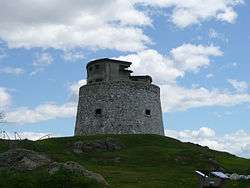
During this war and the War of 1812, the city's location made it a probable target of attacks. This led to the construction of Fort Dufferin and Carleton Martello Tower, one of Canada's fourteen Martello Towers.
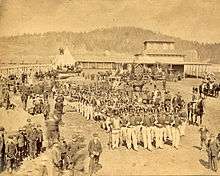
There were various naval battles in the Bay of Fundy fought by HMS Bream (1807) and Brunswicker, both worked out of Saint John.[25]
The Irish
The Irish potato famine (1845–1849) saw the city's largest immigrant influx occur, with the government forced to construct a quarantine station and hospital on Partridge Island at the mouth of the harbour to handle the new arrivals. These immigrants changed the character of the city and surrounding region so that in addition to its Loyalist-Protestant heritage, there was a new Irish-Catholic culture as well. Between 1845 and 1847, approximately 30,000 Irish arrived in Saint John, more than doubling the population of the city. During this period, Saint John was second only to Grosse Isle, Quebec as the busiest port of entry to Canada for Irish immigrants. The Roman Catholic population was largely impoverished and uneducated.
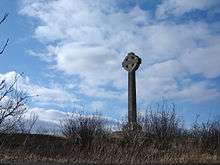
Saint John has often been called "Canada's Irish City". In the years between 1815, when vast industrial changes began to disrupt the old life-styles in Europe, and Canadian Confederation in 1867, when immigration of that era passed its peak, more than 150,000 immigrants from Ireland flooded into Saint John. Those who came in the earlier period were largely tradesmen, and many stayed in Saint John, becoming the backbone of its builders. But when the Great Irish Potato Famine raged between 1845–1852, huge waves of Famine refugees flooded these shores. It is estimated that between 1845 and 1847, some 30,000 arrived, more people than were living in the city at the time. In 1847, dubbed "Black 47," one of the worst years of the Famine, some 16,000 immigrants, most of them from Ireland, arrived at Partridge Island, the immigration and quarantine station at the mouth of Saint John Harbour. However, thousands of Irish were living in New Brunswick prior to these events, mainly in Saint John.
After the partitioning of the British colony of Nova Scotia in 1784 New Brunswick was originally named New Ireland with the capital to be in Saint John.[26]
By 1850, the Irish Catholic community constituted Saint John's largest ethnic group. In the census of 1851, over half the heads of households in the city registered themselves as natives of Ireland. By 1871, 55 per cent of Saint John's residents were Irish natives or children of Irish-born fathers. However, the city was split with tensions between Irish Catholics and Unionist Protestants. From the 1840s onward, Sectarian riots were rampant in the city with many poor, Irish-speaking immigrants clustered at York Point.[27]
In 1967, at Reed's Point at the foot of Prince William Street, St. Patrick's Square was created to honour citizens of Irish heritage. The square overlooks Partridge Island, and a replica of the island's Celtic Cross stands in the square. Then in 1997 the park was refurbished by the city with a memorial marked by the city's St. Patrick's Society and Famine 150 which was unveiled by Hon. Mary Robinson, president of Ireland. The St. Patrick's Society of Saint John, founded in 1819, is still active today.[28]
Metropolis
By 1851 Saint John, with a population of 31,000, was the third largest city in British North America, after Montreal and Quebec City. In April 1854 the ship Blanche arrived in Saint John, and brought cholera to the city. Of 5,000 people stricken, 1,500 died. The periodic outbreaks centered largely in the poorer Catholic district, where people were scarcely over the effects of ship fever (typhus). The care for orphaned children became a priority.
Leadership was in the hands of merchants, financiers, railroad men and ship builders, who envisioned a great economic centre.[29] The city serviced a large rural hinterland in New Brunswick and Nova Scotia, with some 300,000 people. In the 1851–71 era, the business of the city flourished, while the rural hinterland remained stagnant.[30]
The main industry was shipbuilding – it was a major player on the world stage; the industry finally shut down in 2002. Much of the city's shipbuilding industry was concentrated on the mudflats of Courtney Bay on east side. One local shipyard built the sailing ship Marco Polo, and it was at about this time that the city became home to the world's fourth-largest accumulation of vessels.[31] Due to its location for railways and servicing the triangle trade between British North America, the Caribbean, and Britain, the city was poised to be one of Canada's leading urban centres.[32]
Long before the Royal Military College of Canada was established in 1876, there were proposals for military colleges in Canada. After Confederation, a military school was opened in Saint John to conduct officer training for cavalry, infantry and artillery from December to May. Although the British Garrisons initially operated the school at Saint John, Canadian militia staff replaced the British regulars who were recalled from overseas station in 1870–1.[33]
A disastrous fire on June 20, 1877 destroyed a large portion of the central business district. It was the 16th recorded fire in the city and the worst ever. Starting in a warehouse it burned out of control for nine hours. The fire destroyed two-fifths of the city and left 20,000 homeless. Food, tents, clothing, and donations of money came from all over Canada, the United States, and Britain.[34]
Trade unions
The city was a stronghold of trade unions, especially in the docks and the railways. By 1850 working class solidarity was strong among the longshoremen who handled the booming lumber trade. Labour organizations vied with merchants for control of the waterfront casual labor market. However, work-bred feelings of mutualism were often undermined by Protestant-Catholic conflicts. With the introduction of steamers, fast turnaround became even more important and the merchants could not afford job actions, so they compromised. In the World War, the longshoremen succeeded in imposing favourable new work rules and exerting partial control over hiring practices. But by 1919–20 the shipping industry regained its old authority, and hard-pressed longshoremen subsequently abandoned their class-based effort in favor of regional political activism.[35]
In July 1914, the street railway strike and riot occurred. Public opinion favoured the strikers because the company had high fares yet failed to provide quality service. Rioters overturned two streetcars, thwarted a cavalry charge, smashed windows in company offices, and poured cement on a dynamo.[36]
20th century
World Wars

During the First World War, the city became a trans-shipment point for the British Empire's war effort. During the Second World War the port declined in importance due to the U-boat threat. Halifax's protected harbour offered improved convoy marshaling. However, manufacturing expanded considerably, notably the production of veneer wood for De Havilland Mosquito bomber aircraft. On account of the U-boat threat, additional batteries facilities were installed around the harbour.
Saint John's first airport was located north of the business district at Millidgeville. This location on a plateau overlooking the Kennebecasis River was a summer cottage area used by local residents to escape the coastal fog from the Bay of Fundy. Saint John Airport was developed post-war and is located in the eastern part of the city. A leading pioneer was Joseph E. Arrowsmith, the founder of New Brunswick's first passenger airline and a founder of the Saint John Flying Club. His airline was first named "Maritime Airways of Saint John" (1934), then became "Saint John Airline.'[37]
1920s
_(1913)_(14784846925).jpg)
At a time of rural protest in Canada from Ontario to the Prairies, the Maritime Rights Movement was a broad-based protest movement during the 1920s, demanding better treatment from Ottawa. This movement was centered in Saint John, where the city's business leaders politicized the economic crisis and solidified their economic and political leadership.[38]
Urban redevelopment
An urban renewal project in the early 1970s involving a partnership between CPR along with the federal, provincial and municipal governments saw a new harbour bridge and expressway (called the Saint John Throughway) built on former railway lands. The ferry terminal for the service to Digby, Nova Scotia was also relocated from Long Wharf to a new facility on the lower West Side (see Bay Ferries Limited) as the CBD was expanded with new office buildings and downtown retail areas while historic industrial buildings were turned into shops and museums. The skyline in the city boasts office towers and historic properties.
In the 1970s redevelopment of the city and port, most of the port's industrial areas were scheduled to be relocated at a major new deepwater port being considered for the western part of the outer harbour at Lorneville in a major partnership between the Irving conglomerate, NB Power, CPR and the three levels of government. However, the plan fell through in favour of concentrating industrial development on the inner harbour along the mouth of the Saint John River – the very area where the waterfront redevelopment is being proposed (see Saint John Waterfront Development Partnership). Often cited in the media and by politicians as part of Saint John's redevelopment strategy, Harbour cleanup refers to the infrastructure project that will bring an end to the practice of discharging raw sewage into local waterways.
In 1982, a 20 block area of the Uptown area (see Trinity Royal) was designated for historic preservation. A related development in recent years has been waterfront redevelopment for tourist and residential use. This effort increased markedly in the early first decade of the 21st century following the closure and dismantling of the Lantic Sugar refinery in the South End.
References
- Rand, Silas Tertius (1875). A First Reading Book in the Micmac Language: Comprising the Micmac Numerals, and the Names of the Different Kinds of Beasts, Birds, Fishes, Trees... Nova Scotia Printing Company.
- "Geographical names approved in both English and French | Earth Sciences". Archived from the original on 2010-12-31. Retrieved 2013-10-01.
- Dunn, Brenda (2004). A History of Port-Royal-Annapolis Royal, 1605-1800. Nimbus. p. 14. ISBN 978-1-55109-740-4.CS1 maint: ref=harv (link)
- Dunn (2004), pp. 14–15.
- Griffiths, N.E.S. (2005). From Migrant to Acadian: A North American Border People, 1604-1755. McGill-Queen's University Press. p. 49. ISBN 978-0-7735-2699-0.CS1 maint: ref=harv (link)
- Dunn (2004), p. 19.
- Griffiths (2005), p. 60.
- Griffiths (2005), p. 61.
- Dunn (2004), p. 20.
- Poizner, Susan (February–March 2007). "The Lioness of Acadia". The Beaver. Archived from the original on 2012-11-22.
- Dunn (2004), p. 23.
- Murdoch, Beamish (1865). A History of Nova-Scotia, Or Acadie. Vol. I. Halifax: J. Barnes. p. 218.
- Campbell, William Edgar (2005). The Road to Canada: The Grand Communications Route from Saint John to Quebec. Goose Lane Editions. p. 25. ISBN 978-0-86492-426-1.
- Patterson, 1994, p. 131
- Sarty, Roger Flynn; Knight, Doug (2003). Saint John Fortifications, 1630-1956. Goose Lane Editions. p. 29. ISBN 978-0-86492-373-8.
- Plank, Geoffrey (2001). An Unsettled Conquest: The British Campaign Against the Peoples of Acadia. University of Pennsylvania Press. p. 100. ISBN 978-0-8122-0710-1.
- Hannay, James (1909). The History of New Brunswick. Vol.I. Saint John, New Brunswick: John A. Bowes. p. 118.
- Stacy, pp. 26–27; Craig, p. 54.
- Gwyn, Julian (2003). Frigates and Foremasts: The North American Squadron in Nova Scotia Waters, 1745-1815. UBC Press. p. 65. ISBN 978-0-7748-0911-5.
- Godfrey, W.G. (1979). "Studholme, Gilfred". In Halpenny, Francess G (ed.). Dictionary of Canadian Biography. IV (1771–1800) (online ed.). University of Toronto Press.
- Schuyler, George W. (1984). Saint John: Two Hundred Years Proud. Windsor Publications (Canada). p. 122.
- "Arrival of the Black Loyalists: Saint John's Black Community". Heritage Resources Saint John. Archived from the original on 2011-05-19.
- Canada's First City, Saint John: The Charter of 1785 and Common Council Proceedings Under Mayor G.G. Ludlow, 1785-1795. Saint John, New Brunswick: Lingley. 1962. p. 30.
- Canada's First City (1962), pp. 30–33.
- Smith, Joshua M. (2011). Battle for the Bay: The Naval War of 1812. Goose Lane Editions. ISBN 978-0-86492-759-0.
- "The Partition of Nova Scotia". Winslow Papers. University of New Brunswick. 21 June 2005.
- Winder, Gordon M. (Spring 2000). "Trouble in the North End: The Geography of Social Violence in Saint John 1840-1860". Acadiensis. XXIX (2): 27. JSTOR 30303222.
- Cave, Rachel (16 March 2016). "Saint John St. Patrick's Society clings to men-only tradition". CBC New Brunswick.
- Wallace, C.M. (Fall 1976). "Saint John Boosters and the Railroads in the Mid-Nineteenth Century". Acadiensis. XI (1): 71–91. JSTOR 30302585.
- Buckner, Phillip; Reid, John G., eds. (1994). The Atlantic Region to Confederation: A History. University of Toronto Press. ISBN 978-1-4875-1676-5.CS1 maint: ref=harv (link)
- How 1993, p. 33
- Buckner & Reid (1994), pp. 333–335.
- Preston, Richard Arthur (1969). Canada's RMC: A history of the Royal Military College. Published for the Royal Military College Club of Canada by the University of Toronto Press.
- Phillips, Doris (1977). "Nova Scotia's Aid for the Sufferers of the Great Saint John Fire (June 20th, 1877)". Nova Scotia Historical Quarterly. 7 (4): 351–366.
- Babcock, Robert H. (Spring 1990). "Saint John Longshoremen During the Rise of Canada's Winter Port, 1895–1922". Labour/Le Travail. 25: 15–46. doi:10.2307/25143339. JSTOR 25143339.
- Babcock, Robert H. (Spring 1982). "The Saint John Street Railwaymen's Strike and Riot, 1914". Acadiensis. XI (2): 3–27. JSTOR 30302675.
- Wright, Harold E. (Winter 2009). "Pioneering in Maritime Air Transport". C.A.H.S.: The Journal of the Canadian Aviation Historical Society. 47 (4): 122–127.
- Nerbas, Don (Winter–Spring 2008). "Revisiting the Politics of Maritime Rights: Bourgeois Saint John and Regional Protest in the 1920s". Acadiensis. XXXVII (1): 110–130. JSTOR 30303121.
- Mcgahan, Elizabeth W. (4 March 2015) [10 September 2012]. "Saint John". The Canadian Encyclopedia (online ed.). Historica Canada.